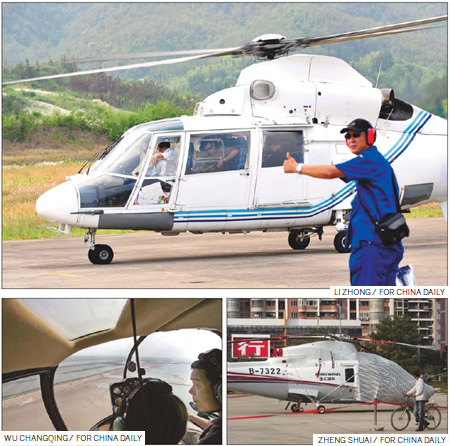Biz Unusual
Flight in vogue as nouveau riche reach up to the skies
By Wang Ying (China Daily)
Updated: 2010-12-07 13:37
 |
Large Medium Small |
Opening the skies
For pilots like Xu and Guan, hope arrived last month in the form of a joint announcement by the State Council and Central Military Commission that the nation's low-altitude airspace will be "gradually opened" to promote the general aviation industry.
Under the move, private aircraft will be automatically cleared to fly at heights of up to 1,000 meters.
General aviation refers to all flights other than military and scheduled airline and cargo flights, both private and commercial. It covers a wide range of activities, including flight training, air rescue and aerial firefighting, as well as gliding and skydiving.
"It's great news," said Wang Bin, who runs a framing company in Yiwu. "I'm really looking forward to it."
The businessman bought his first plane from France in 2006 on the recommendation of an American friend. However, by the end of the following year, he calculated that, because of the restrictions and maintenance costs, he had spent more than 20 million yuan for just 36 hours of flight time.
Industry insiders also welcomed the announcement, while some of the more optimistic suggested that opening China's airspace will provide the next economic growth engine in general aviation.
"In North America, general aviation is very popular; there are 19,000 airports, 590,000 pilots and 224,000 aircrafts for the use of general aviation in the US alone," said Zhang Yan, Party secretary of the discipline working committee at Xi'an Yanliang National Aviation High-Tech Industrial Base in Shaanxi province.
"The industry in the US turns out more than $150 billion revenue each year, accounting for nearly 2 percent of the country's GDP," he added.
In contrast, there are fewer than 1,000 aircrafts, 2,000 pilots and 300 airports for the use of the general aviation in China. Meanwhile, although 60 percent of planes in the US are privately owned, the percentage in China is only about 20 percent.
"This gap gives (companies) a great opportunity once the low-altitude airspace is opened. It will become the nation's new economic growth engine," said Zhang, who is also director of the Shaanxi Northwest General Aviation Association.
He explained that the industry probably has the highest rate of business turnover, with every 1 yuan of investment yielding a return of 10 yuan. The ratio for the automotive industry is 1:4.
Employment boost
Experts say another potential benefit is that every job created could bring about 12 more employment opportunities thanks to the long industrial chain, which includes aircraft and parts manufacturing, sales, maintenance and reparation and pilot training.
According to Lu Yongguang, an industrial analyst for Central China Securities, the "private air service is growing rapidly", although "administrative hurdles" are standing in its way.
Zhang agreed and said China is probably the only country in his impression that has low-altitude airspace restriction.
Some investors are already eyeing the many opportunities in general aviation.
Niu Yankai this year founded Zhejiang Pinghu Jiulongshan Aviation Club after studying and comparing the markets in China and overseas.
"For the first stage we'll invest 60 million yuan into Jiulongshan Airport (in Zhejiang) and then we'll start to recruit helicopter pilots for both adventure and exploration services," he said. "Meanwhile, we're also in talks with US partners to offer more facilities at the club."
Zhang Feng, director of the Aircraft Owners and Pilots Association, said there are more than 30 registered aviation clubs and many more unregistered ones across the country. He suggested that a lot of effort will be needed to help Chinese businesses to take advantage of the loosened airspace restriction, such as improving ground infrastructure construction, flight management systems and pilot training.
A report released in September by aircraft manufacturer Boeing predicts that China will need 70,600 pilots and 96,400 aircrew members in the next 20 years. Wenzhou pilot Xu in believes it will not be a problem getting more people on board.
"I believe everybody has dreamed of flying at least once in their life because it's a human nature to push past the limits," he said. "The experience of controlling the aircraft and flying in the sky is amazing. Nothing can compare with that feeling."
Yu Ran in Shanghai contributed to this story.
 |
| Clockwise from top: People board a helicopter to enjoy the first flight of the Friends of Wind Club on May 16, 2009, when the group was established in Hangzhou, Zhejiang province; A cyclist looks at a S-76 helicopter in downtown Fuzhou, capital of Fujian province, on Feb 11 this year. It is owned by Shanghai-based entrepreneur Zou Jianming; Li Linhai, another entrepreneur in Shanghai, flies his helicopter on June 29, 2005. Li bought the 4-million-yuan aircraft in the US. |







